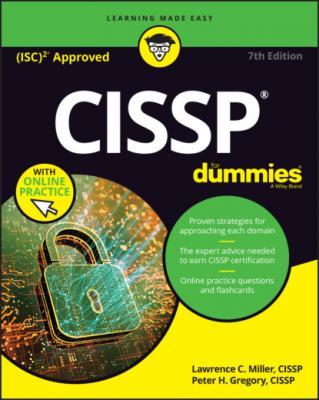CISSP For Dummies. Peter H. Gregory
Чтение книги онлайн.
Читать онлайн книгу CISSP For Dummies - Peter H. Gregory страница 12
 style="font-size:15px;"> Identity and Access Management (IAM)
style="font-size:15px;"> Identity and Access Management (IAM)
Security Assessment and Testing
Security Operations
Software Development Security
You Must Be This Tall to Ride This Ride (And Other Requirements)
The CISSP candidate must have a minimum of the equivalent of five cumulative years of professional (paid), full-time, direct work experience in two or more of the domains listed in the preceding section. Full-time experience is accrued monthly and requires full-time employment for a minimum of 35 hours per week and 4 weeks per month to get credit for 1 month of full-time work experience. Part-time experience can also be credited if you are employed fewer than 35 hours per week but at least 20 hours per week; 1,040 hours of part-time experience would be the equivalent of 6 months of full-time experience. Credit for work experience can also be earned for paid or unpaid internships. You’ll need documentation from the organization confirming your experience or from the registrar if you’re interning at a school.
The work experience requirement is a hands-on one; you can’t satisfy the requirement just by having “information security” listed as one of your job responsibilities. You need to have specific knowledge of information security and to perform work that requires you to apply that knowledge regularly. Some examples of full-time information security roles that might satisfy the work experience requirement include (but aren’t limited to)
Security analyst
Security architect
Security auditor
Security consultant
Security engineer
Security manager
Examples of information technology roles for which you can gain partial credit for security work experience include (but aren’t limited to)
Systems administrator
Network administrator
Database administrator
Software developer
For any of these preceding job titles, your particular work experience might result in your spending some of your time (say, 25 percent) doing security-related tasks. This is legitimate for security work experience. Five years as a systems administrator, for example, spending a quarter of your time doing security-related tasks, earns you 1.25 years of security experience.
Furthermore, you can get a waiver for a maximum of one year of the five-year professional experience requirement if you have one of the following:
A four-year college degree (or regional equivalent)
An advanced degree in information security from one of the National Centers of Academic Excellence in Cyber Defense (CAE-CD)
A credential that appears on the (ISC)2-approved list, which includes more than 45 technical and professional certifications, such as various SANS GIAC certifications, Cisco and Microsoft certifications, and CompTIA Security+ (For the complete list, go to https://www.isc2.org/Certifications/CISSP/Prerequisite-Pathway.)
See Chapter 2 to learn more about relevant certifications on the (ISC)2-approved list for an experience waiver.
www.nsa.gov/resources/educators/centers-academic-excellence/cyber-defense.
If you don’t have the minimum required experience to become a CISSP, you can still take the CISSP certification exam and become an associate of (ISC)2. Then you’ll have six years to meet the minimum experience requirement and become a fully certified CISSP.
Preparing for the Exam
Many resources are available to help the CISSP candidate prepare for the exam. Self-study is a major part of any study plan. Work experience is also critical to success, and you can incorporate it into your study plan. For those who learn best in a classroom or online training environment, (ISC)2 offers CISSP training seminars.
We recommend that you commit to an intense 60-day study plan leading up to the CISSP exam. How intense? That depends on your personal experience and learning ability, but plan on a minimum of 2 hours a day for 60 days. If you’re a slow learner or reader, or perhaps find yourself weak in many areas, plan on four to six hours a day — and more on the weekends. But stick to the 60-day plan. If you need 360 hours of study, you may be tempted to spread this study over a 6-month period for 2 hours a day. Consider, however, that committing to six months of intense study is much harder (on you, as well as your family and friends) than two months. In the end, you’ll likely find yourself studying only as much as you would have in a 60-day period anyway.
Studying on your own
Self-study might include books and study references, a study group, and practice exams.
Begin by downloading The Ultimate Guide to the CISSP from the (ISC)2 website at https://www.isc2.org/Certifications/CISSP. This guide provides a good overview of the CISSP certification and the exam, as well as links to several helpful CISSP study resources.
Next, read this (ISC)2-approved book, and review the online practice at www.dummies.com. (See the introduction for more information.) CISSP For Dummies is written to provide a thorough and essential review of all the topics covered on the CISSP exam. Then read any additional study resources to further your knowledge and reinforce your understanding of the exam topics. You can find several excellent study resources in the official CISSP Certification Exam Outline. Finally, rinse and repeat: Do another quick read of CISSP For Dummies as a final review before you take the actual CISSP exam.
Joining a study group can help you stay focused and provide a wealth of information from other security professionals' broad perspectives and experiences. It’s also an excellent networking opportunity (the talking-to-real-people type of network, not the TCP/IP type of network)! Study groups or forums can be hosted online or at a local venue. Find a group that you’re comfortable with and flexible enough to accommodate your schedule and study needs. Or create your own study group!
Finally,